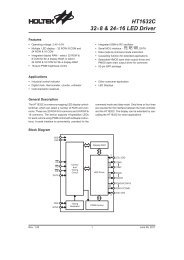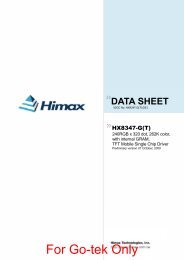MCP73831 Datasheet - Adafruit
MCP73831 Datasheet - Adafruit
MCP73831 Datasheet - Adafruit
Create successful ePaper yourself
Turn your PDF publications into a flip-book with our unique Google optimized e-Paper software.
<strong>MCP73831</strong><br />
PowerDissipation = ( V – V ) × I DDMAX PTHMIN REGMAX<br />
Where:<br />
V DDMAX = the maximum input voltage<br />
I REGMAX = the maximum fast charge current<br />
V PTHMIN = the minimum transition threshold<br />
voltage<br />
Power dissipation with a 5V, ±10% input voltage source<br />
is:<br />
PowerDissipation = ( 5.5V – 2.7V) × 550mA = 1.54W<br />
This power dissipation with the battery charger in the<br />
SOT23-5 package will cause thermal regulation to be<br />
entered as depicted in Figure 6-3. Alternatively, the<br />
2mm x 3mm DFN package could be utilized to reduce<br />
charge cycle times.<br />
6.1.1.3 External Capacitors<br />
The <strong>MCP73831</strong> is stable with or without a battery load.<br />
In order to maintain good AC stability in the Constant-<br />
Voltage mode, a minimum capacitance of 4.7 μF is<br />
recommended to bypass the V BAT pin to V SS . This<br />
capacitance provides compensation when there is no<br />
battery load. In addition, the battery and interconnections<br />
appear inductive at high frequencies. These<br />
elements are in the control feedback loop during<br />
Constant-Voltage mode. Therefore, the bypass capacitance<br />
may be necessary to compensate for the<br />
inductive nature of the battery pack.<br />
Virtually any good quality output filter capacitor can be<br />
used, independent of the capacitor’s minimum<br />
Effective Series Resistance (ESR) value. The actual<br />
value of the capacitor (and its associated ESR)<br />
depends on the output load current. A 4.7 μF ceramic,<br />
tantalum or aluminum electrolytic capacitor at the<br />
output is usually sufficient to ensure stability for output<br />
currents up to a 500 mA.<br />
Placing a programming resistor from the PROG input to<br />
V SS enables the device. Allowing the PROG input to<br />
float or by applying a logic-high input signal, disables<br />
the device and terminates a charge cycle. When<br />
disabled, the device’s supply current is reduced to<br />
25 μA, typically.<br />
6.1.1.6 Charge Status Interface<br />
A status output provides information on the state of<br />
charge. The output can be used to illuminate external<br />
LEDs or interface to a host microcontroller. Refer to<br />
Table 5-1 for a summary of the state of the status<br />
output during a charge cycle.<br />
6.2 PCB Layout Issues<br />
For optimum voltage regulation, place the battery pack<br />
as close as possible to the device’s V BAT and V SS pins.<br />
This is recommended to minimize voltage drops along<br />
the high current-carrying PCB traces.<br />
If the PCB layout is used as a heatsink, adding many<br />
vias in the heatsink pad can help conduct more heat to<br />
the backplane of the PCB, thus reducing the maximum<br />
junction temperature. Figures 6-4 and 6-5 depict a<br />
typical layout with PCB heatsinking.<br />
V SS<br />
V BAT<br />
FIGURE 6-4:<br />
V SS<br />
C OUT<br />
R LED LED<br />
R PROG<br />
<strong>MCP73831</strong> C IN<br />
V DD<br />
Typical Layout (Top).<br />
6.1.1.4 Reverse-Blocking Protection<br />
The <strong>MCP73831</strong> provides protection from a faulted or<br />
shorted input. Without the protection, a faulted or<br />
shorted input would discharge the battery pack through<br />
the body diode of the internal pass transistor.<br />
6.1.1.5 Charge Inhibit<br />
The current regulation set input pin (PROG) can be<br />
used to terminate a charge at any time during the<br />
charge cycle, as well as to initiate a charge cycle or<br />
initiate a recharge cycle.<br />
V BAT<br />
FIGURE 6-5:<br />
V DD<br />
Typical Layout (Bottom).<br />
DS21984A-page 14<br />
© 2005 Microchip Technology Inc.

















